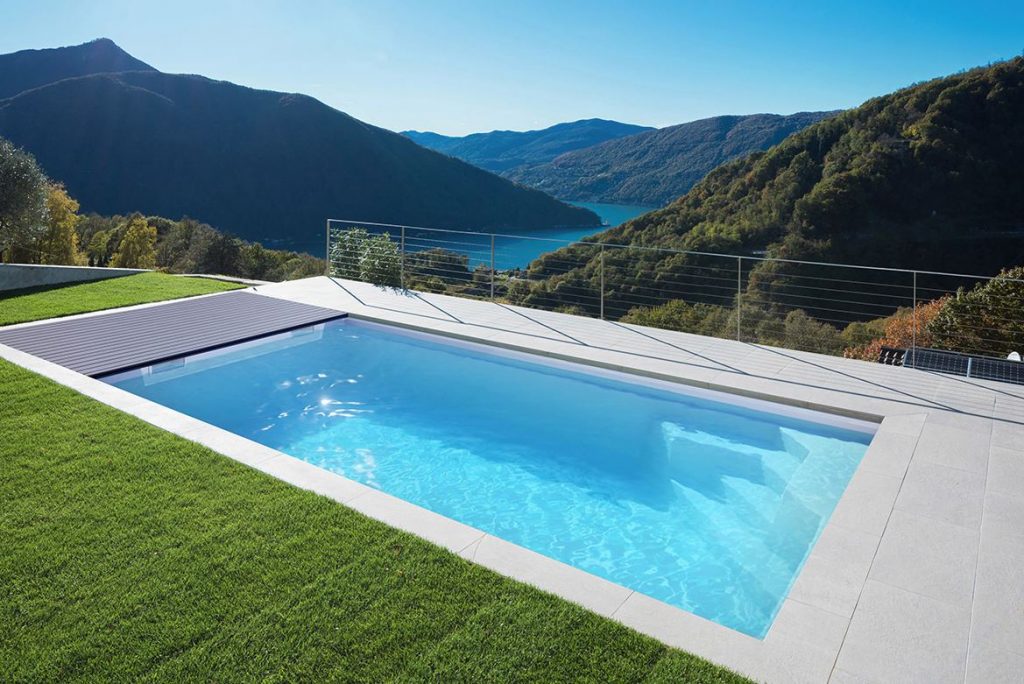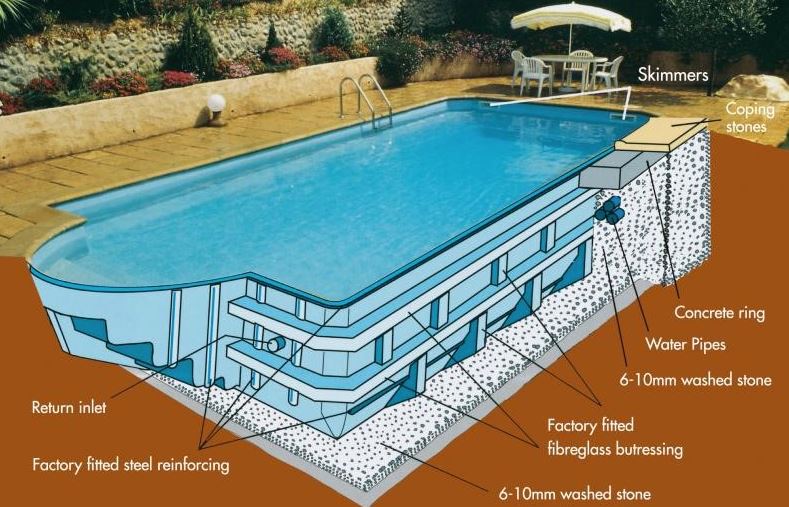Diving into the serene waters of your fibreglass pool can be a refreshing escape from the daily grind, especially during warm, sun-drenched days. Fibreglass pools, celebrated for their ease of installation and smooth finish, have become popular among homeowners seeking functionality and aesthetic appeal. However, like all things of value, they demand a certain level of upkeep to stay pristine. Regular maintenance ensures a sparkling, inviting appearance and extends the longevity of your pool, allowing you and your loved ones to enjoy endless splashes and joyful memories.
This blog post explores the pivotal aspects of maintaining a fibreglass pool, focusing on the crucial resurfacing process. From unravelling the intricacies of fibreglass pools and their common issues to delving into the nitty-gritty of daily, weekly, and monthly maintenance, we will walk you through a comprehensive guide designed to keep your aquatic haven in tip-top shape.
Additionally, we will shed light on the signs that indicate the need for resurfacing, its benefits, and the importance of choosing the right professionals for the job. Whether you are a new pool owner navigating the waters of pool care or a seasoned one looking to brush up on your maintenance knowledge, this guide is your go-to resource for keeping your fibreglass pool pristine and ready for enjoyment. So, let’s dive in and explore the refreshing world of fibreglass pool maintenance and resurfacing!

Understanding Fiberglass Pools
Fibreglass pools are composite structures, primarily made of fibreglass strands, woven together and bonded with resins to form a strong, lightweight, and flexible material. The smooth gel coat finish on the surface gives it a glossy appearance and acts as a barrier to algae growth and staining, thereby reducing maintenance efforts.
The inherent characteristics of fibreglass include its durability, non-porous nature, and flexibility, allowing it to withstand fluctuations in temperature and ground movement. Furthermore, fibreglass pools are known for their quick installation and lower initial cost than concrete pools, making them an attractive option for many homeowners.
One of the notable benefits of fibreglass pools is their minimal maintenance requirements. The non-porous surface inhibits algae growth, reducing the need for chemicals and scrubbing. Additionally, the smooth finish reduces the risk of injuries and abrasions with rougher pool surfaces.
Fibreglass pools also boast a quicker installation, typically taking a few weeks compared to months for concrete pools. This means less backyard disruption and quicker access to your oasis. Moreover, fibreglass pools are renowned for their energy efficiency, as they maintain temperature better and require less heating, thereby saving on utility bills.
Despite their advantages, fibreglass pools are challenging. Common issues include osmotic blisters, surface cracks, and discolouration. Osmotic blisters occur when water permeates the gel coat, leading to swelling and blistering. Though usually cosmetic, surface cracks can indicate structural problems if not addressed promptly. Discolouration, on the other hand, can result from imbalanced pool chemistry, affecting the pool’s aesthetic appeal.
Regular Maintenance Tips
Daily Maintenance
- Skimming the Surface: Regular skimming removes leaves, debris, and insects from the pool surface. This keeps the pool looking clean and prevents the accumulation of organic matter, which can affect water chemistry and cause algae growth.
- Checking Water Level: The water level should be monitored daily to ensure it remains at the appropriate level, usually halfway up the skimmer opening. Too low or high water levels can affect the efficiency of the skimming and filtration systems.
- Monitoring Pool Chemistry: Regularly checking and adjusting the pool’s chemical balance is crucial. Imbalances can lead to issues like algae growth, discolouration, and damage to the pool surface. Daily monitoring helps in early detection and correction of any imbalances.
Weekly Maintenance
- Vacuuming the Pool: Weekly vacuuming is essential to remove dirt and debris from the pool floor, which can cause staining and water imbalance if left unattended. Regular vacuuming also helps in maintaining the pool’s aesthetic appeal.
- Cleaning Pool Filters: The pool filters trap dirt and contaminants, and cleaning them weekly ensures the efficient functioning of the filtration system. Neglecting this can lead to cloudy water and increased strain on the pool pump.
- Inspecting Pool Equipment: Regular inspection of pool equipment such as pumps, heaters, and lighting is essential to detect and address any issues promptly. Early detection of malfunctions prevents major damage and ensures the safety and enjoyment of the pool.
Monthly Maintenance
- Checking for Leaks: A monthly check for leaks in and around the pool is crucial. Unattended leaks can lead to water loss, increased utility bills, and structural damages. Early detection and repair are essential to prevent extensive damages and costs.
- Inspecting the Pool Shell for Damages: Regular inspection of the pool shell can help detect any cracks, blisters, or discolouration early on. Addressing these issues promptly ensures the pool’s structural integrity and aesthetic appeal are maintained.
- Adjusting Water Chemistry: While daily monitoring of pool chemistry is essential, a thorough monthly check and adjustment of chemical levels are crucial. This helps maintain the optimum chemical balance, preventing issues like algae growth, discolouration, and damage to the pool surface.
Fiberglass Pool Resurfacing
Signs Your Pool Needs Resurfacing
- Stains and Discoloration: Over time, the glossy finish of a fibreglass pool can lose its charm due to stains and discolouration, often caused by chemical imbalances, metal objects, or organic matter. This aesthetic concern is a clear indication that your pool might need resurfacing.
- Blisters and Cracks: The appearance of blisters and cracks on the pool surface is not only unappealing but could also indicate underlying structural issues. These damages necessitate immediate attention and typically signal the need for resurfacing.
- Surface Roughness: If the once-smooth surface of your pool becomes rough to the touch, this is a clear sign of wear and tear, indicating that a resurface is to restore its original texture.
The Resurfacing Process
- Draining the Pool: The initial step in resurfacing involves draining the pool completely to provide clear access to the damaged surface.
- Preparing the Surface: Once drained, the existing gel coat is sanded down to create a rough surface for the new coating to adhere properly. Any blisters or cracks are repaired during this stage.
- Applying the New Gelcoat: A fresh layer of gel coat is meticulously applied, restoring the pool’s glossy, smooth finish and sealing any repairs made.
Benefits of Resurfacing
- Aesthetically Pleasing: Resurfacing rejuvenates the appearance of your pool, bringing back the lustre and appeal, making it look brand new.
- Extends Pool Life: Addressing surface issues promptly through resurfacing can significantly extend the life of your pool by preventing further damage.
- Improves Pool Hygiene: A smooth, new surface is less susceptible to algae and bacteria growth, thus improving the overall hygiene of the pool.

Choosing the Right Professionals for Resurfacing
When resurfacing your pool, hiring an experienced fibreglass pool specialist is paramount. Professionals with a track record of success can ensure the job is done correctly, thereby minimising the risk of future issues and maximising the lifespan of your pool.
Before hiring, it’s essential to research and review potential contractors. Look for customer testimonials, online reviews, and any accolades or certifications. This will give you a sense of their reputation and the quality of their work.
It’s advisable to get quotes from multiple contractors and evaluate their services. Consider not only the cost but also the warranty, timeline, and quality of the materials they intend to use.
Additional Tips for Keeping Fiberglass Pool Pristine
Investing in quality pool cleaning equipment can make a significant difference in maintaining the pristine condition of your fibreglass pool. Efficient skimmers, vacuums, and filters will ensure that impurities are effectively removed, maintaining a clean and inviting pool.
Accurate balancing of pool chemical levels is critical in preventing issues like algae growth and discolouration. Regular testing and adjustments will help maintain the right chemical balance, thereby preserving the integrity and appearance of your pool.
Proactively addressing any repair issues as soon as they arise will prevent minor problems from escalating into major damages. Regular inspection and prompt repairs will ensure your fibreglass pool’s longevity and aesthetic appeal.
Maintaining a fibreglass pool might seem daunting, but it can be a manageable and rewarding endeavour with regular care, the right knowledge, and timely interventions. By understanding the nuances of fibreglass pools, adhering to regular maintenance routines, recognizing when resurfacing is needed, and choosing the right professionals, you can enjoy a pristine, inviting pool for many years. So, dive in, enjoy the refreshing waters, and let the joy of owning a fibreglass pool wash over you!

